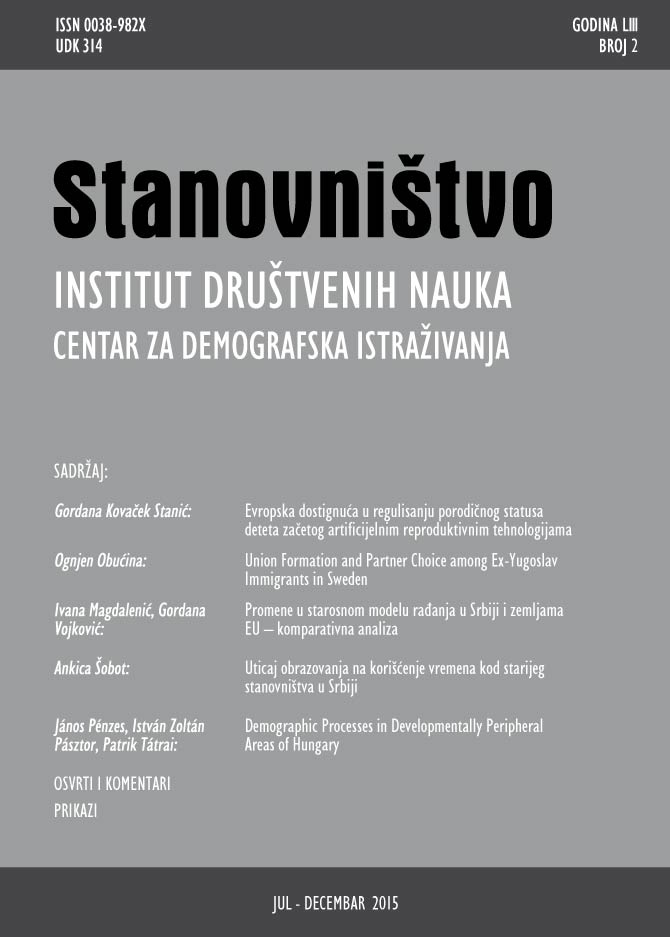Demographic Processes in Developmentally Peripheral Areas of Hungary
Demographic Processes in Developmentally Peripheral Areas of Hungary
Author(s): János Pénzes, Istvan Zoltan Pastor, Patrik TátraiSubject(s): Social Sciences, Sociology, Demography and human biology, Gerontology, Ethnic Minorities Studies, Identity of Collectives
Published by: Институт друштвених наука
Keywords: aging; depopulation; Hungary; peripheral areas; Roma population
Summary/Abstract: The current study investigates the demographic processes and challenges of the Hungarian peripheral settlements. Demographic challenges can be regarded as important consequences of the social and economic disadvantages in spatial terms. However, the interrelating negative demographic tendencies cause even more backward situation blocking or hindering the development. As a part of the analysis the peripheral settlements were delimited according to a previous complex and detailed study. Seven variables were chosen from this set after a systematic narrowing procedure requiring multiple steps. Eight different multivariate statistical methodologies were applied to create complex indicators as a kind of essence and to make spatial categories by the extent of peripherality. The objective of the current analysis is to discover the demographic characteristics of the peripheral settlements and to detect the spatial disparities. Additional important objective is to point out the correlation between backwardness and the investigated demographic phenomena. In order to detect the tendencies, the census databases between 1980 and 2011 were used and local datasets on Roma population were applied. Data aggregations and manipulations were used instead of difficult multivariate statistical methods. Depopulation is one of the greatest challenges in Hungary. Backward areas are primarily characterized by decreasing and dynamically decreasing population number, with striking disparities, but there were growing communities among them as well. In general, strong depopulation could be detected among these settlements (approximately 23 percent decrease between 1980 and 2011). Some small villages in Northern and Southwestern Hungary with enormous population decrease will foreseeably face complete depopulation within few years.The strongly peripheral group of settlements, primarily small sized villages, faced intense decrease in rate of natural change. But dynamic population growth was also detected, which is caused by natural increase that was typical almost in every peripheral settlement with Roma majority. Migration loss tends to correlate with the extent of peripherality, as increasing values of migration balance are accompanied by decreasing ratio of peripheral settlements in the area. The dynamic population aging of Hungary could be detected since the 1980s. The ratio of peripheral settlements represents one peak in the case of the group of settlements with more than 40 percent of elderly population. Even more prominent ratio of peripheral settlements could be detected in the juvenile groups of settlements. The most characteristic and extended areas with aging population could be found in the Zemplén area, in the Northern-Cserehát in Borsod-Abaúj-Zemplén County, in the Western Transdanubia (in Zala County) and in the Hungarian Great Plain – in mosaic-like pattern. The ratios of Roma population reflect the scale of peripherality. Every settlement having Roma majority (more than 130 villages) was in the peripheral categories. Extended ethnic change could be predicted in Northeastern and Southwestern Hungary and near the Middle Tisza valley. Presented demographic processes - in our opinion - will make the backwardness of most of the peripheral settlements stable.
Journal: Stanovništvo
- Issue Year: 53/2015
- Issue No: 2
- Page Range: 87-111
- Page Count: 25
- Language: English

